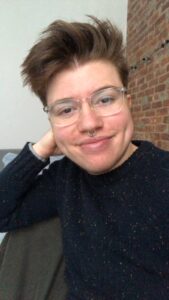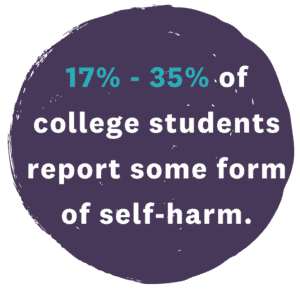According to Mental Health America, self-injury, also known as self-harm, self-mutilation, or self-abuse occurs when someone intentionally and repeatedly harms themselves in a way that is impulsive and not intended to be lethal. Although self-harm is not classified as a mental health disorder, it is often a symptom of mental health conditions, like eating disorders, substance use disorders, depression, and anxiety.
Like many others, Eugene’s self-harm was triggered by untreated mental illness and the stress of dealing with a chronic illness.
Trigger Warning: Self-harm & Suicidal ideation
Q: What would you like people to know about you?

Q: What was your life like before recovery?
A: I felt so stuck that I didn’t think there could be any other way. On paper, things were going really well, I was working as an RA and doing some incredible fellowship work, but behind the scenes the dysfunction was immense.
I was spending all my energy on work and neglected my own needs, substituting self-care for my addictive behavior, self-harm. My mental health was in shambles, I was isolating and stuck in a mindset of anxiety and paranoia. The only way I knew to cope that worked for me was to self-harm, so I was doing it all the time. Eventually, it became like an instinct. Several times I had to go to the hospital to treat the aftermath, but that didn’t stop me. I would lie, get discharged, and go back to the studio to finish my homework.

Once it got to the point where I was told to leave school and couldn’t fight for my life anymore, I decided as a last-ditch effort to throw myself head-on into recovery. I will admit that I never expected it to work, at the time, I rationalized that I couldn’t end things until I had tried everything in my power to change them, and I thought that once it failed I could leave in peace. But the thing about rock bottom is that there’s really nowhere to go but up.
Recovery means choosing to take care of myself in a healthy way every day because if I don't, I could relapse into addictive tendencies.Eugene
Q: What do addiction and recovery support services look like on your campus? How did they get there?

Q: What challenges is your CRC is currently facing in the wake of COVID-19?
A: The CRC at Pratt is only a few years old and has seen a lot of challenges during the COVID-19 pandemic. Due to financial losses that the school is facing, we have had our budget slashed to zero, which has made programming difficult to run. We are also currently running virtually, which makes it harder to share vulnerable things in recovery and support meetings, due to the lack of privacy some people have in their homes. Running virtually also makes it harder to run programming since our members are located across the world.
While at first, it was difficult to reach students who could be helped by our program due to everything being virtual, we have actually seen an increase in membership this semester. My guess is the pandemic is making things difficult on people struggling with addiction and driving them to seek out resources such as ours.
Q: What do you want people to know about the importance of addiction and recovery support services on your campus?
A: Mostly I think it’s important that people on campus know that they exist, and are available if they need them. It is too often the case that people are struggling alone, and I think it needs to be normalized and known that these resources are available and that they are already paying for the opportunity to use them. There is nothing wrong with needing help, and there is no judgment here. Recovery programming can and regularly does save lives, and it is so important to fund and support.
I am learning to say no when I need to and working on adapting things to work for me with my disabilities.Eugene
Q: What does recovery mean to you?
A: At the very beginning of my recovery, I needed a lot of support. I got hospitalized again, and afterward went to a residential mental health treatment center, and then a partial hospitalization and intensive outpatient program. I took treatment very seriously, and I think that is vital.

Q: Describe your plans for the future now that you are in recovery.
A: Since being in recovery I have come back to school part-time, and I am excited to be developing my business while I am in school. I am working to raise funds to adopt a service dog, and volunteer to run a peer support art therapy group every week. I am learning to say no when I need to and working on adapting things to work for me with my disabilities. Recently I’ve started getting into adaptive sports, which has been really exciting!
